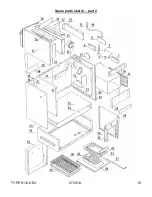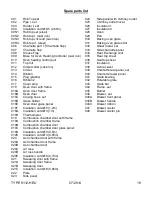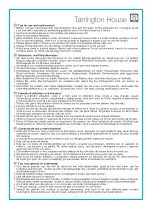
TYPE 9112-HEU
07/2014
7
When you are firing the appliance for the first time, ensure sufficient ventilation of the room, until
the protective coatings have completely burned off. Once satisfied that that the coatings are no
longer present the cooker is safe to use for the purpose of cooking food.
Before ignition open the furnace door and check if the grate is clean. Take twists of paper, lay out
tiny chips of dry soft wood on it, then lay larger pieces of dry wood on the chips and then light the
paper. Special matches are available to carry out this operation at a distance from the flame.
Before ignition open the ignition flap (Drawing 3). Open the air supply under the grate through the
air rose to the maximum and also the secondary air supply.
The cooker cannot be used without a water pump connected to the domestic central
heating system to prevent damage to the heat exchanger caused by overheating. The
pump should be already in operation when starting the fire!!!
After the fuel is ignited close the combustion chamber door and when the fuel burns through,
stoke up. After a layer of burning embers is formed you can add more fuel in batches. Make sure
not to extinguish the fire by adding excessive amounts of fuel too quickly.
Gradually prolong the intervals of stoking, so that the final interval is once an hour. The average
fuel consumption is 3 – 4 kg of fuel per hour. Adding of fuel shall be done manually or by means of
a suitable shovel. Full combustion can be visually easily checked: no heavy smoke can be seen
rising from the chimney (except the time immediately after stoking up).
If you add half the amount of fuel every thirty minutes and perform grating at the same time, the
combustion performance will improve.
The appliance output can be controlled by the supply of air under the grate and by the amount
and type of fuel. When operating the appliance at the rated thermal output and burning wood, the
primary air supply shall be opened to approx. 20 %, the secondary air supply closed. From time to
time clean the grate by means of the poker. If the appliance emits smoke into the room during
stoking up, close the air supply. Do not overheat the appliance by too intensive stoking up and
grating!
The entire combustion chamber can be filled with fuel. Make sure that the fuel does not fall out of
the combustion chamber during stoking up. In case of bad draught or weather conditions use
smaller wood logs.
Recommendations for setting of stabilisation operation:
Lay a wood log of 190 mm diameter and 450 mm length on the bottom burning layer. Close both
the primary and secondary air supply. With these settings the appliance should keep burning for
up to 3 hours.
Cooking on the Appliance Hob Top
The range above the combustion chamber is designed for fast cooking. With the described set
operation, 2 litres of water in a pot with flat bottom of a diameter of 180 cm with a lid should start
boiling in 15 minutes.
During cooking watch out for boiling over. If it happens, remove as much of the spillage
immediately and when finished cooking clean the remainder using a damp towel, detergent and
finally using a dry towel. If the dirt bakes in, it is more difficult to remove later. From time to time
(depending on the frequency of operation) wipe the range down with vegetable oil.
In the area above the oven the range has a lower temperature - this part of the range is suitable
for slow cooking and for keeping food war. Use pots with a flat bottom for best results.
Appliance Operation








































